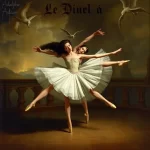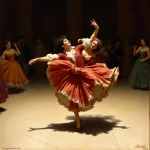Ballet: Le Talisman (Riccardo Drigo, 1889)

Introduction
Ballet, a classical dance form known for its grace and precision, has produced numerous masterpieces over the centuries. One such gem is “Le Talisman,” a ballet composed by Riccardo Drigo and choreographed by Marius Petipa. Premiered on January 25, 1889, at the Imperial Mariinsky Theatre in St. Petersburg, Russia, “Le Talisman” is a captivating tale of love, magic, and adventure. The ballet’s plot revolves around the mystical talisman that holds the power to control destiny, weaving a narrative rich in romance and fantasy.
Historical Background
Creation and Development
“Le Talisman” was created during a period of significant artistic and cultural development in Russia. The late 19th century was a time when ballet was flourishing, with the Imperial Ballet in St. Petersburg at the forefront of this golden age. The ballet was inspired by a blend of literary sources and folklore, drawing on themes of magic and mysticism that were popular in the era.
The collaboration between Marius Petipa, the renowned French choreographer, and Riccardo Drigo, an Italian composer, was instrumental in bringing “Le Talisman” to life. Petipa’s innovative choreography combined with Drigo’s evocative music created a ballet that was both visually and aurally enchanting. Other key figures in the production included set designer Matvey Shishkov and costume designer Ivan Vsevolozhsky, who contributed to the ballet’s overall aesthetic appeal.
Premiere and Reception
“Le Talisman” premiered on January 25, 1889, at the Imperial Mariinsky Theatre in St. Petersburg. The initial reception was overwhelmingly positive, with critics and audiences alike praising the ballet for its imaginative storyline, stunning choreography, and beautiful music. Notable early performances featured some of the era’s most celebrated dancers, including Pierina Legnani, who played the lead role of Niriti.
The ballet enjoyed several revivals in the years following its premiere, each time reaffirming its place in the repertoire of classical ballet. Despite its initial success, “Le Talisman” eventually fell into relative obscurity, only to be revived and appreciated by modern audiences and ballet companies.
Synopsis of the Ballet
Act I Summary
The ballet opens in the mystical realm of the gods, where the goddess Niriti is introduced. Niriti is in possession of a powerful talisman that can control fate. She descends to Earth, where she meets and falls in love with a mortal prince named Vayou. The act sets the stage for the central conflict, as Niriti’s divine nature and the talisman’s power create obstacles for their love.
Act II Summary
In the second act, Niriti and Vayou’s love is tested by various challenges. They encounter magical creatures and face trials that threaten to separate them. The talisman plays a crucial role in their journey, as its power is both a blessing and a curse. The act is filled with dramatic moments and showcases the ballet’s intricate choreography and elaborate set designs.
Act III Summary
The final act brings the story to its climax and resolution. Niriti and Vayou confront the ultimate test of their love and the talisman’s power. The act culminates in a grand pas de deux, symbolizing their union and triumph over adversity. The ballet concludes with a celebration of their love, highlighting the themes of destiny and the transformative power of love.
Finale
The conclusion of “Le Talisman” is both poignant and uplifting. The resolution of the central conflict and the union of Niriti and Vayou underscore the ballet’s themes of love, destiny, and the triumph of good over evil. The finale is a testament to the enduring power of love and the belief in a higher destiny.
Musical Composition
Composer’s Role
Riccardo Drigo, an accomplished composer and conductor, played a pivotal role in the creation of “Le Talisman.” Drigo’s music is characterized by its melodic richness and emotional depth, perfectly complementing Petipa’s choreography. Notable pieces within the score include the grand pas de deux and the various character dances that highlight the ballet’s diverse themes and settings.
Musical Themes and Motifs
The score of “Le Talisman” features recurring musical themes and leitmotifs that enhance the narrative and emotional impact of the ballet. Drigo’s use of leitmotifs to represent characters and themes adds a layer of complexity to the music, making it an integral part of the storytelling. The music’s ability to convey the mystical and romantic elements of the plot is one of the ballet’s defining features.
Famous Recordings and Performances
Over the years, “Le Talisman” has been performed by various ballet companies, each bringing their unique interpretation to the music. Notable recordings of the ballet’s score include performances by the Bolshoi Ballet and the Mariinsky Ballet, both of which have contributed to the preservation and appreciation of Drigo’s work.
Choreography and Dance
Choreographer’s Vision
Marius Petipa’s vision for “Le Talisman” was one of grandeur and innovation. Known for his meticulous attention to detail and his ability to create complex, yet fluid choreography, Petipa’s work on this ballet is a testament to his genius. He introduced several innovations in the choreography, including intricate group dances and elaborate solos that showcased the dancers’ technical prowess.
Signature Dance Numbers
“Le Talisman” features several signature dance numbers that have become iconic in the world of ballet. The grand pas de deux between Niriti and Vayou is a highlight, showcasing the dancers’ skill and the emotional depth of their characters. Other notable scenes include the character dances in Act II, which add a touch of exoticism and fantasy to the ballet.
Notable Interpretations
Over the years, different productions of “Le Talisman” have brought unique interpretations to the choreography. Some have emphasized the mystical elements of the story, while others have focused on the romantic aspects. Notable interpretations include those by the Bolshoi Ballet and the Mariinsky Ballet, both of which have contributed to the ballet’s enduring legacy.
Characters and Roles
Main Characters
- Niriti: The goddess who possesses the talisman. She is a central figure in the ballet, representing love and destiny.
- Vayou: A mortal prince who falls in love with Niriti. His character embodies bravery and devotion.
Supporting Characters
- Magical Creatures: Various mystical beings that Niriti and Vayou encounter on their journey.
- Gods and Goddesses: Other divine figures who play a role in the story’s unfolding.
Famous Dancers
Notable dancers who have portrayed the lead roles in “Le Talisman” include Pierina Legnani, who originated the role of Niriti, and Pavel Gerdt, who played Vayou. Their performances set a high standard for future interpretations of these characters.
Cultural and Artistic Impact
Influence on Ballet and Dance
“Le Talisman” has had a significant influence on the world of ballet and dance. Its innovative choreography and compelling music have inspired other works and choreographers. The ballet’s themes of love and destiny continue to resonate with audiences, making it a timeless piece in the ballet repertoire.
Cultural Significance
The ballet’s place in popular culture is marked by its adaptations in various forms of media, including film and theater. Its themes and characters have been referenced in literature and other art forms, highlighting its enduring cultural significance.
Legacy and Revivals
“Le Talisman” has seen several major revivals and reinterpretations over the years. Modern adaptations have brought new life to the ballet, ensuring its continued relevance and appreciation. The ballet remains a celebrated work, performed by leading ballet companies around the world.
Iconic Productions
Historic Productions
Historic productions of “Le Talisman” include its original 1889 premiere at the Imperial Mariinsky Theatre and subsequent performances by the Bolshoi Ballet. Key figures involved in these productions include Marius Petipa, Riccardo Drigo, and Pierina Legnani.
Contemporary Productions
Recent productions of “Le Talisman” have brought new interpretations to the ballet, incorporating modern elements while staying true to the original vision. These contemporary productions often feature updated set and costume designs, as well as innovative choreography that reflects current trends in ballet.
Production Design
The set, costume, and lighting design in various productions of “Le Talisman” have played a crucial role in bringing the ballet’s magical world to life. From the elaborate costumes of the gods and goddesses to the mystical settings of the different acts, the production design enhances the overall experience of the ballet.
Critical Reception and Reviews
Initial Critical Response
At the time of its premiere, “Le Talisman” received positive reviews from critics, who praised its imaginative storyline, stunning choreography, and beautiful music. The ballet was lauded for its artistic innovation and emotional depth.
Modern Reviews
Contemporary critics and audiences continue to appreciate “Le Talisman” for its timeless themes and artistic excellence. Modern reviews often highlight the ballet’s relevance and its ability to captivate audiences with its blend of romance, fantasy, and drama.
Fun Facts and Trivia
Behind-the-Scenes Stories
One interesting anecdote from the production of “Le Talisman” involves Pierina Legnani, who was known for her incredible technical skill. During rehearsals, she reportedly performed 32 fouettés en tournant, a feat that became a hallmark of her career.
Notable Performers
Famous dancers associated with “Le Talisman” include Pierina Legnani, Pavel Gerdt, and more recently, dancers from the Bolshoi Ballet and Mariinsky Ballet who have brought their unique interpretations to the roles.
Trivia
- The talisman in the ballet is a symbol of fate and destiny, central to the plot’s development.
- Riccardo Drigo composed the music for several other ballets, including “The Magic Flute” and “Harlequinade.”
- Marius Petipa is considered one of the most influential choreographers in the history of ballet, with works like “The Sleeping Beauty” and “Swan Lake” to his name.
Conclusion
Summary of the Ballet’s Importance
“Le Talisman” is a significant work in the world of ballet, known for its imaginative storyline, stunning choreography, and beautiful music. The collaboration between Marius Petipa and Riccardo Drigo resulted in a ballet that continues to captivate audiences with its themes of love, destiny, and magic.
Final Thoughts
“Le Talisman” remains a timeless piece in the ballet repertoire, celebrated for its artistic innovation and emotional depth. Whether you are a seasoned ballet enthusiast or a newcomer to the art form, experiencing a performance of “Le Talisman” is a journey into a world of enchantment and beauty.
FAQ
What is the central theme of this ballet?
The central theme of “Le Talisman” is the power of love and destiny, as represented by the mystical talisman that controls fate.
Who are the main characters in this ballet?
The main characters are Niriti, a goddess who possesses the talisman, and Vayou, a mortal prince who falls in love with her.
What is the most famous dance number in this ballet?
The grand pas de deux between Niriti and Vayou is one of the most famous dance numbers in “Le Talisman.”
How long does a typical performance of this ballet last?
A typical performance of “Le Talisman” lasts approximately two hours, including intermissions.
Are there any modern adaptations of this ballet?
Yes, there have been several modern adaptations and revivals of “Le Talisman,” each bringing new interpretations to the ballet while staying true to its original vision.
Why is this ballet considered important in the history of dance?
“Le Talisman” is considered important in the history of dance for its innovative choreography, beautiful music, and its enduring themes of love and destiny. It has influenced other works and continues to be celebrated by ballet companies around the world.





